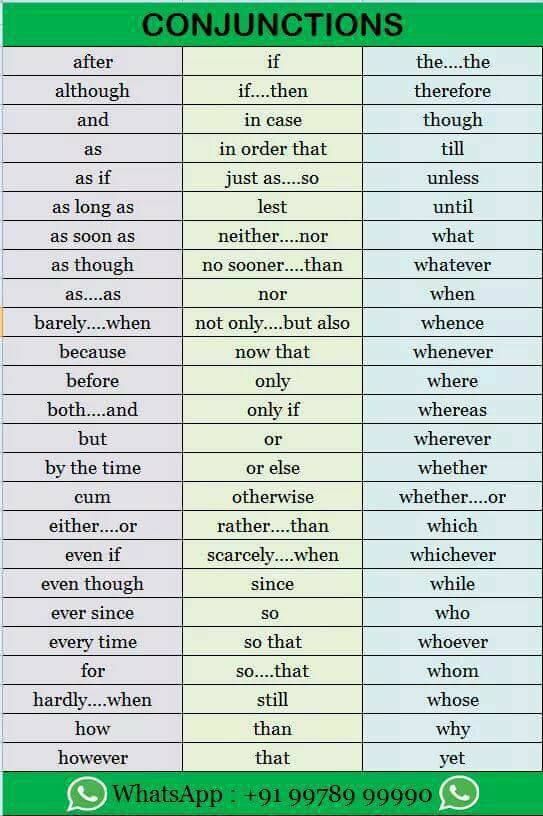Is is a verb or a noun? Is it a preposition? In this post, we have learned that the word is a verb and functions solely as a verb to describe a state of being or existence. Is is a verb.
Is or a conjunction or verb?
Or is a conjunction that connects two or more possibilities or alternatives. It connects words, phrases and clauses which are the same grammatical type: Which do you prefer?
What type of a word is is?
As detailed above, ‘is’ is a verb. Verb usage: He is a doctor. Verb usage: Should he do the task, it is vital that you follow him.
Are is a verb or?
In most cases, the word “are” is classified as a verb, more specifically as a linking verb. When used as a linking verb, it connects the subject with the other parts of the sentence that provides additional information about it.
Is is a linking verb?
While the most common linking verbs are am, is, are, was, were, being, and been, sensory words like look and felt are also used as linking verbs.
What are the 7 conjunctions?
English has seven coordinating conjunctions—for, and, nor, but, or, yet, so—which you can remember using the mnemonic FANBOYS: For indicates causation: “We left a day early, for the weather was not as clement as we had anticipated.”
Is is a helping verb?
Am, is, are, was, and were are helping verbs! Be, being, and been are three more helping verbs. They’re useful words! We love those helping verbs!
Is is a auxiliary verb?
Give some examples of auxiliary verbs. Am, is, are, was, were, will, have, has, had, may, might, can, could, shall, should, must, ought to, would, etc., are some examples of auxiliary verbs.
What is the use of is?
Use is with singular subjects and are with plural subjects. Collective nouns usually take is, but you can use are if you need to emphasize the individuals who belong to the group.
What are is and are called?
An auxiliary verb (or a helping verb as it’s also called) is used with a main verb to help express the main verb’s tense, mood, or voice. The main auxiliary verbs are to be, to have, and to do. They appear in the following forms: To Be: am, is, are, was, were, being, been, will be.
Are is a type of?
As detailed above, ‘are’ can be a verb or a noun.
Are is a pronoun?
Subject pronouns are also used if they rename the subject. They will follow to be verbs, such as is, are, was, were, am, will be, had been, etc. Examples: It is he.
Is is a linking or action verb?
Be, am, is, are, was, were, has been, any other form of the verb “be”, become, and seem. There are other verbs that can be both linking verbs and action verbs. All of the sense verbs; look, smell, touch, appear, sound, taste, and feel can be linking verbs.
Is is always a linking verb?
The word ‘always’ is not a linking verb. It never acts as a verb in a sentence because it is an adverb. Adverbs are a different part of speech than verbs. They modify verbs, adjectives, and other adverbs.
Is is a linking or helping verb?
The main helping verbs are: be, am, is, are, was, were, do, did, have, has, had. Example sentences: “We have eaten.” (HAVE is the helping verb, and EATEN is the main verb.
Which is not a conjunction?
The word on is not a conjunction. The words and, or, but are conjunctions that are used to join two words together to form a complete sentence. In English grammar, conjunction is a part of speech that is used to connect words, phrases, or clauses.
Is or a conjunction or verb?
Or is a conjunction that connects two or more possibilities or alternatives. It connects words, phrases and clauses which are the same grammatical type: Which do you prefer?
What are the 5 most common conjunctions?
The most common coordinating conjunctions are for, and, nor, but, or, yet, and so; you can remember them by using the mnemonic device FANBOYS. I’d like pizza or a salad for lunch. We needed a place to concentrate, so we packed up our things and went to the library.
What are the 12 conjunctions?
There are many subordinating conjunctions but the most common are: after, although, as, as if, because, before, how, if, since, than, though, unless, until, when, where and while.
Which one is not a conjunction?
The word on is not a conjunction. The words and, or, but are conjunctions that are used to join two words together to form a complete sentence. In English grammar, conjunction is a part of speech that is used to connect words, phrases, or clauses.
Is have a linking verb?
When “be” is used as an ordinary verb, it is always a “linking verb.” When “have” is used as an ordinary verb, it is never a “linking verb.”
What is verb example?
A verb is the action or state of being in a sentence. Verbs can be expressed in different tenses, depending on when the action is being performed. Here are some examples: Example: Jennifer walked to the store. In this sentence, walked is the verb that shows an action.









